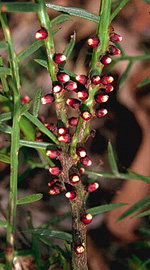 |
This small family of parasites from the tropics and temperate parts of South and Central America, Africa, Europe and Asia includes the world's largest flower, Rafflesia arnoldii, although the flowers of most species are minute. In Australia a single species, Pilostyles hamiltonii, parasitises the stems of shrubby pea species in south-western Western Australia.
Characteristic features of the family Rafflesiaceae in Australia include: - parasites without stems, leaves or roots, the vegetative plant reduced to filamentous, fungus-like strands within the tissues of its host, with only the flowers emerging
- flowers small (in Australia), unisexual, with a perianth of 4-10 segments, borne sessile on the stems of the host
- male flowers with many anthers beneath a fleshy, disc-like central column; female flowers with an inferior ovary
- fruit a fleshy (later drying) red berry with many minute seeds
Description
Perennial herbs, partially or totally parasitic on the stems of the host. Plants lacking recognisable stems or leaves. Chlorophyll absent and the whole plant whitish, yellowish or brownish. Internal secretions not obvious. Plants glabrous. Male and female flowers occurring on separate plants. Inflorescences acaulescent on stems of host, consisting of solitary flowers. Bracts and bracteoles present. Pollination by insects. Flowers odourless or malodorous, sessile or rarely stalked. Floral disc present. Perianth regular, of 1 whorl, with 4–6 free petaloid segments, imbricate in bud, pink, orange or red, without contrasting markings, succulent or leathery; claws absent; lobes ±entire. Fertile stamens numerous, not clearly correlated with and free of the perianth segments, free of the carpels, fused into a column, all ±equal. Staminal filaments absent. Anthers opening by terminal pores, 1-celled. Ovary part-inferior. Carpels 4–6, fused; ovary with 1 locule. Style absent and the stigma sessile and annular. Ovules numerous, stalked; placentation parietal. Fruit fleshy, becoming dry, indehiscent; a berry; the perianth on the maturing fruit dry and persistent. Disseminule micro-surface ±smooth, red, dull. Seeds numerous per fruit. Aril absent. Cotyledons 0. Embryo straight.
(Note: this description has been generated from the coded data compiled for the key. Any errors in the key data will be reflected in the descriptions.)
A treatment of the family Rafflesiaceae has been published in:
Flora of Australia 22: 147-150.
Australian genera of Rafflesiaceae (as recognised for the Flora of Australia)
Pilostyles

|
  |

Pilostyles hamiltonii (flowers emerging from host Daviesia sp.)
Photo: A.S.George © A.S.George
|
 |
|